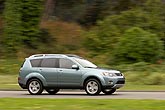Recent Articles
Popular Makes
Body Types
2007 Mitsubishi Outlander First Drive
Down a run in the bottom of the ninth, team Mitsubishi puts the Outlander up to bat
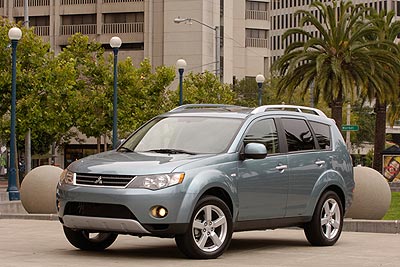
Mitsubishi Outlander – First Drive: We may be a car-crazy nation, but let's face it – we can only buy so many of our beloved four-wheeled obsessions. With annual sales in the 16-17 million range, it would seem ideal to be an automotive manufacturer, a car dealer, or anyone even remotely tied to the industry – aftermarket folks, insurers, mechanics, and a battery of others. With all of that new product hitting the streets, not to mention the lucrative used-car market that thrives with all of those trade-ins and lease returns, money should be rolling in hand over fist. Tell that to General Motors, Ford Motor Company, and even Nissan – all are experiencing some degree of difficulty, from a slight detour in demand to a nosedive in market share. Blame it on competition – domestic, Japanese, Korean, European, and soon, Chinese – and buyers' unflinching desire for quality, value, and in some cases, style. Most of the media's ink is relegated to such issues as they relate to Detroit, but there's a Japanese player, a once-competitive force in the U.S. market, that lies on the brink of pulling up stakes, calling it a day, and bidding farewell. Mitsubishi, creator of the original AWD turbocharged Eclipse hatchback, former big-league engineering partner to Chrysler, and proud parent of the current Lancer Evolution, is on life support. Injecting the Raider pickup and redesigned Eclipse into the lineup have failed to improve the prognosis. There's one remedy left, the 2007 Mitsubishi Outlander, due to arrive this November. Thankfully for Mitsubishi's sake, this rig's got some legs to stand on. There's a 220-horsepower V6 engine and six-speed Sportronic automatic transmission standard on every model, attractive features like Bluetooth connectivity and a rear DVD entertainment system, a unique split tailgate design, available four-wheel-drive traction, a tow capacity peaking at 3,500 pounds, EPA highway fuel economy reaching 27 mpg, up to seven-passenger seating, and its sleek shape makes it arguably more appealing than many competitors. Above all, the Outlander is backed by a 100,000-mile powertrain warranty. Unfortunately, that's of little comfort when offered by a company with a questionable future. Another issue is price – Mitsubishi suggests the range will fall between about $19,000 to less than $30,000 fully loaded. For a company that so desperately needs a successful vehicle, let's just say it sure as heck better carry a competitive figure on the sticker. Consequently, if priced right, anyone in the market for a small SUV, or versatility in general, would be well served to give the Outlander a look. The truck itself has a lot to offer, and the local Mitsubishi dealer will be eager to greet you.
Model Mix
Model Mix Expected to range between about $19,000 and $30,000, the 2007 Outlander will be available in ES 2WD, LS 2WD, LS 4WD, XLS 2WD, and XLS 4WD trims, with items such as side- and side-curtain airbags, as well as an optional rear DVD setup and a touch-screen navigation system. Reflective of the small SUV market, the one currently bursting at the seams with choices, the 2007 Mitsubishi Outlander arrives to entice the fuel-efficiency-craving masses in no fewer than five trims. With base prices loosely estimated to range between $19,000 and less than $30,000 fully loaded, every model will be powered by the same 220-horsepower V6 engine and six-speed automatic transmission, with the drivetrain available in front- or four-wheel-drive variants. Positioned as the entry-level Outlander, the ES is available only as a front-driver, though it comes well-equipped with automatic headlights, a rear wiper, a tilting but not telescoping steering wheel, a trip computer, air conditioning, a height-adjustable driver's seat, keyless entry, a fold-and-tumble second-row split bench, and desirable safety items such as front-side and side-curtain airbags as well as antilock brakes and a tire-pressure monitoring system. A 140-watt sound system with speed-compensated volume plays CDs and MP3s, cruise control ensures a steady speed, and controls for the power windows and door locks are within easy reach. Falling into the middle of the 2007 Mitsubishi Outlander lineup is the LS model, available with either front- or four-wheel-drive. The LS adds standard equipment including black roof rails, deeply tinted rear glass, 16-inch alloy wheels in lieu of the ES's steel rims, a leather-wrapped shift knob and steering wheel with audio controls, a rear cargo cover for an element of security, and connectivity for the optional Bluetooth system. Also available at an extra cost is a Sun & Sound Package, featuring a 650-watt Rockford-Fosgate Punch sound system with an iPod jack, six months of free Sirius satellite radio, and a power sunroof; and an Entertainment Package offering a rear DVD system with a nine-inch screen and wireless headphones. For buyers seeking the most standard creature comforts in a small SUV, Mitsubishi offers the 2007 Outlander XLS which, like the LS, is available as a front-driver or four-wheeler. The XLS is distinguished by silver exterior trim, 18-inch alloy wheels, automatic climate control, a hideaway third-row seat that bumps capacity up to seven passengers, sturdy tie-down bars on the walls of the cargo area, a keyless ignition system, and magnesium paddle shifters. Options include the Sun & Sound Package, not to mention a Luxury Package, complete with high-intensity discharge headlights, leather upholstery, a power driver's seat, heated front seats, and a touch-screen navigation system with a 30GB hard drive, availing six gigabytes for storing personal music choices. When coupled with the Entertainment Package (and with the vehicle in Park), the navigation screen can display the same DVD showing on the rear's fold-down screen.
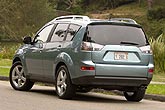
Nuts and Bolts
Nuts and Bolts Every 2007 Outlander features a six-speed Sportronic automatic transmission mated to a 220-horsepower V6. Front- and four-wheel-drive variants are available, with the latter capable of towing up to 3,500 pounds. With the exception of the 166-horsepower 2007 Honda CR-V, shoppers will find the current and upcoming crop of small/midsize suvs to be available with lively, if not exhilarating, engines. Consider the Toyota RAV4 with its optional 269-horsepower V6, the Mazda CX-7 and its 244 turbocharged ponies, and the redesigned Hyundai Santa Fe with up to 242 horses. Starting in November, the all-new 2007 Mitsubishi Outlander joins the fray, adding a standard 3.0-liter, 24-valve, MIVEC (Mitsubishi Valve-timing Electronic Control) V6 to the mix, which carries a clean PZEV emissions rating for California. Horsepower registers a respectable 220 at 6,250 with 204 lb.-ft. of torque peaking at 4,000 rpm. EPA-rated fuel economy measures 20 mpg city/27 mpg highway for front-wheel-drive models, or 19/26 mpg in four-wheel-drive guise. Our straight highway drive from San Francisco to Los Angeles in an XLS 4WD, at rather quick speeds, returned 23.1 mpg, while a subsequent run in mixed traffic yielded 19.9 mpg. Those EPA figures are only a smidge lower than last year, despite a gain of two cylinders, 60 horsepower, and 42 lb.-ft. of torque. Regular 87-octane fuel is recommended. Also new for 2007 is a six-speed, manually-interactive automatic transmission that, again, is standard issue across the Outlander lineup. It replaces 2006's five-speed manual and four-speed automatic. XLS models feature paddle shifters formed from magnesium – designers claim the material is warmer and softer to the touch than aluminum or steel, and superior to the plastic parts used by other manufacturers. Designers claim these are identical to those slated to be used on a "future performance sedan." Guess we'll have to wait and see what that, uh, evolves into. Under the 2007 Outlander, weighing in between 3,527 (ES 2WD) and 3,791 (XLS 4WD) pounds, is a MacPherson strut front suspension complemented by a multi-link rear setup and anti-sway bars. Front-wheel-drive models can tow up to 2,000 pounds, while the four-wheel-drive versions can pull up to 3,500 pounds. Stretching 182.7 inches in length, the Mitsubishi is 1.6 inches longer than the Toyota RAV4, and about two inches shorter than the Mazda CX-7 and Hyundai Santa Fe. ES and LS models accommodate five passengers, while the XLS with its fold-away third-row bench ups that figure to seven. But that bench, amounting to little more than a seat frame wrapped in stretch fabric, is possibly the most inhospitable of the small SUV offerings. Interior measurements are on par with the competition for the most part, though space is decidedly tight for those in the third-row. The seven-passenger RAV4 provides 37.2 inches of third-row headroom, 30 inches of legroom, 52.6 inches of shoulder room, and 43.3 inches of hip space. In comparison, the Outlander offers respective measurements of 35.4, 27.7, 49.8, and 39.1 inches. Given the limited use of that rearmost bench, many shoppers, whether opting for the Mitsubishi or one of its competitors, may find that to be of little concern. Not so with topics like brakes and steering. Engineers have fitted the 2007 Outlander with discs all around to ensure steady, sure stopping power, aided by ABS, electronic brake-force distribution, and active skid and traction control (ASTC). Steering is the job of a variable-assisted rack-and-pinion assembly. Four-wheel-drive Outlanders feature a rotary dial between the front seats which controls three settings. In 2WD mode, all of the engine's power is directed to the front wheels; in 4WD Auto, power is delivered to the rear wheels when slippage occurs or up to 40 percent under full throttle (drops to 25 percent over 40 mph); and 4WD Lock is best suited for optimal traction on slippery or rough surfaces by pushing added power to the rear wheels immediately (up to 60 percent under full throttle). Interestingly, the 4WD settings can be used on any road surface, and selecting a mode can be done at any speed.
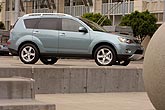
Design
Design XLS models feature a two-passenger third-row bench that's best left stored, leaving a flat load floor that can be extended by dropping the small lower tailgate. The Outlander's overall style is clean, or what designers call "taut, tidy, with refined detail." As evidenced by the seemingly countless choices, small SUVs are hot right now, fueled in no small part by the public's increasing demand for more fuel-efficient vehicles. Competition is fierce, leaving the decent but unloved 2006 Mitsubishi Outlander in many a Toyota's, Honda's, and Hyundai's dust. Based on the company's new C-platform, the same to be used for the upcoming Lancer and Evolution models, the redesigned 2007 Outlander is essentially a new vehicle. Company designers call it a "smart crossport." Under the hood is a more powerful engine, and the design is fresh with subtle cues paying tribute to other models. The front end treatment, including sporty headlights and a large lower air intake, is swept back and imparts a sense of speed, while the bulging wheel wells offer a touch of muscularity. The aluminum roof panel cuts 11 pounds from the curb weight and lowers the center of gravity, thereby, theoretically, improving handling. Side flanks are clean, or what Mitsubishi calls "taut, tidy, with refined detail." However you wanna put it, we think this is one of the more attractive offerings in the class, and those Lexus RX 350-inspired clear LED taillights only improve the picture. Most notable about the new Outlander's design is its tailgate. Pop the lid, and it rises just like most every other SUV, allowing access to a good-sized cargo area. ES and LS models get a cubby under the storage floor; XLS models include the third-row bench, which with its multiple straps and folding headrests, is a rickety contraption best left stored. With that seat hidden away, the resulting flat load floor can be extended by dropping the lower section of the tailgate. Load height is improved considerably by unlatching this mini-gate, which is also capable of supporting up to 440 pounds of cargo. Inside, the 2007 Mitsubishi Outlander's new instrument panel and sporty overall design is meant to "raise anticipation for a great driving experience, with a strong emphasis on precision and details." To that end, a sporty steering wheel (leather-wrapped on LS and XLS) greets the driver, along with a prominently displayed tachometer, attractive silver accent trim, and supportive bucket seats boasting decent upper and lower bolsters. Every model gets the manually-interactive transmission with the shift gate thoughtfully positioned on the driver's side, a sliding front armrest, and a fold-down rear armrest with integrated cup holders. Storage is plentiful, including dual gloveboxes, a large covered cubby atop the dash, door and seatback pockets, and 72.6 cubic feet of cargo space when the optional third-row is stowed and the second-row split bench is folded and tumbled forward.
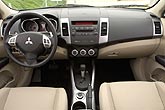
Driving Impressions
Driving Impressions Compared to the much less powerful 2007 Honda CR-V and more powerful Mazda CX-7, the Outlander feels downright quick and more responsive. The ride is a bit firm, but that's the typical trade-off for decent handling. Small and midsize SUVs can be a confusing breed. Because of their size, some shoppers may expect a nimble ride at an affordable price, yet upon visiting a dealer they test drive a top-heavy rig that otherwise handles like a plain ol' sedan – a plain ol' sedan with a hefty premium tacked onto the sticker. And then along comes the 2007 Mitsubishi Outlander which, while not worthy of complete disassociation from that characterization, at least points itself in a different direction. Before and during our test drive along the coast north of San Francisco, Mitsubishi designers and engineers suggested that since it's built on the same platform, the Outlander has a vein of the upcoming Lancer Evolution running through it. We have a hard time cuddling up to that idea, even after hundreds of miles behind the Outlander's wheel, but we will agree that Mitsubishi has built a vehicle that is dynamically superior to many of its competitors. Take, for instance, the 220-horsepower engine. Crank ‘er up, take a second to hear the slightly-tuned exhaust, shift into Drive, and drop the throttle. That sort of takeoff will illicit a fair amount of suspension squat as the weight transfers to the rear, and unveils noticeable but controllable torque-steer, with the 204 lb.-ft. of torque providing for a lively, if not exactly hair-raising launch. Gradual starts in daily traffic are obviously smoother, accented by a somewhat touchy gas pedal. Once up to speed, the 3.0-liter V6 proves adequate – it will seldom be described as powerful, but there's never a problem merging, performing tight highway passes, or darting through traffic. Compared to the much less powerful 2007 Honda CR-V, the Outlander is downright quick, and it even feels more responsive than the Mazda CX-7, despite a relative dearth of power. The Mitsubishi's smooth-shifting six-speed automatic transmission aids in the effort, always working to maintain the proper engine speed for the situation. Of course, the down side is the tranny's tendency to hunt, a point we noticed while piloting the hilly sections of I-5 en route from San Francisco to Orange County. But, you can always use the manual feature on the shift knob, or in XLS models, the large paddle shifters that remain stationary with the steering column. The manual mode offers nearly instantaneous shifts; depressing the XLS's upshift paddle for a few seconds directs the transmission back to regular Drive mode. For comparison, we drove an Outlander LS 2WD north, and then an XLS 4WD several hundred miles south to our office in Orange County. On high-speed curves, the LS 2WD's tail felt more inclined to step out, whereas the XLS 4WD stayed tucked in. Body roll was evident but controlled, and the steering was light yet responsive, providing plenty or feedback and road feel at all speeds. Shoppers looking for the Evo's handling in an SUV body need to take their futile search elsewhere – the Outlander does a fine job of connecting the driver to the road, but its miles away from the feeling of being one with the road in the Evo. Whether it's the enthusiast or Commuter Ken who finds themselves in the Outlander, they'll appreciate the well-modulated and effective four-wheel disc brakes. Not so welcome is wind noise that seeps in around the A-pillars, even at relatively low speeds. Also, drivers and passengers alike may notice a ride that's a bit firmer than some of the competition. Though far short of jarring, the effects of rough roads and pot holes are often directly transferred to the Outlander's occupants. To some, that's a fair and expected trade-off for decent handling. That's fine in Mitsubishi's eyes, too, as they are looking for success with buyers seeking a driver-focused, enjoyable ride, and not another soulless people-mover.
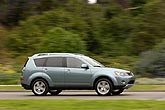
FAQ
FAQ Each Outlander is backed by a great warranty spanning 60,000 miles for basic coverage and 100,000 miles for the powertrain. Mitsubishi expects the Outlander will receive five stars in crash tests. Does Mitsubishi still offer long a warranty? Yes. The 2007 Mitsubishi Outlander is backed by a five-year/60,000-mile basic warranty, 10 years/100,000 miles of powertrain coverage, and rust protection spanning seven years or 100,000 miles. How does the 2007 Outlander perform in crash tests? The 2007 Mitsubishi Outlander has yet to be tested, but the company expects five-star ratings. The pictures seem to show a skid plate under the front fascia. Is that correct? Looks can be deceiving. That is simply a plastic panel, and is not functional, unless you're barreling down a trail of pillows and marshmallows.
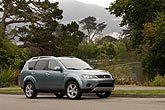
Specifications
Specifications Competitors for the 2007 Mitsubishi Outlander include the Acura RDX, Chevrolet Equinox, Chrysler Pacifica, Dodge Nitro, Ford Escape, Honda CR-V, Hyundai Santa Fe, Hyundai Tucson, Jeep Compass, Jeep Liberty, Kia Sportage, Kia Sorento, Land Rover LR2, Mazda Tribute, Mazda CX-7, Mazda CX-9, Mercury Mariner, Nissan Murano, Pontiac Torrent, Saturn VUE, Subaru Forester, Subaru Outback, Suzuki Grand Vitara, Suzuki XL7, and the Toyota RAV4 Test Vehicle: 2007 Mitsubishi Outlander XLS 4WD Price of Test Vehicle: $28,000 (estimated) Engine Size and Type: 3.0-liter V6 Engine Horsepower: 220 at 6,250 rpm Engine Torque: 204 lb.-ft. at 4,000 rpm Transmission: Six-speed Sportronic automatic Curb Weight, lbs.: 3,791 EPA Fuel Economy (city/highway): 19/26 mpg Observed Fuel Economy: 19.9 mpg Length: 182.7 inches Width: 70.9 inches Wheelbase: 105.1 inches Height: 67.7 inches Legroom (front row/second row/third row): 41.6/36.8/27.7 inches Headroom (front row/second row/third row): 40.3/38.3/35.4 inches Max. Seating Capacity: Seven Max. Cargo Volume: 72.6 cubic feet Max. Towing Capacity, lbs.: 3,500 Ground Clearance: 8.5 inches Competitors: Acura RDX, Chevrolet Equinox, Chrysler Pacifica, Dodge Nitro, Ford Escape, Honda CR-V, Hyundai Santa Fe, Hyundai Tucson, Jeep Compass, Jeep Liberty, Kia Sportage, Kia Sorento, Land Rover LR2, Mazda Tribute, Mazda CX-7, Mazda CX-9, Mercury Mariner, Nissan Murano, Pontiac Torrent, Saturn Vue, Subaru Forester, Subaru Outback, Suzuki Grand Vitara, Suzuki XL7, Toyota RAV4
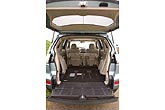
2nd Opinion – Chee
2nd Opinion – Chee With the Outlander, the good and the bad balance out to acceptable, but this new small SUV still deserves attention for its style, comfort, ride and handling, and innovative tailgate. It seems like yesterday when the Mitsubishi Outlander first came around. And – heck – it was, three years to be exact, and my how the years have just whizzed by. Perhaps it's because the Outlander debuted as just another little SUV in a sheetmetal sea of hulking top heavy vehicles. Except for the price and the warranty, it just melted into the scenery of Hondas and Toyotas, no one paying heed until that gravelly-voiced dude would come on the radio and grumble something about zero-percent financing. Yeah. It's been a long three years for Mitsubishi. Even with a new Eclipse and a hand-shaking, knee-knocking Evolution, sales are flat and people are largely unexcited about the company's wares, something it hopes the 2007 Outlander will change. And it might, because style counts and this is a very attractive SUV with some interesting innovations and a driving demeanor that balances out the good and bad, winding up, for the most part, at acceptable. Take a look? Sure you should. And when you do, pay careful note to the tailgate feature in back, which works to make your grocery-haulin' life a little easier. Also pay attention to the plastics inside the cabin for they require a significant upgrade, and the lack of stereo knobs on the instrument panel. Audio controls are mostly, and frustratingly, managed via the navigation center. Seating comfort and legroom is right up there with the best in its class, however, and the powertrain – a V6 engine with a six-speed shift-o-matic – is peppy but unrefined with a little too much gear hunting going on. Overall, however, the Outlander offers nicely responsive steering, acceptable handling for an SUV, and more than enough power for most. All told, this Mitsu is better looking than the Toyota RAV4, though not quite able to match it in terms of precision and quality.
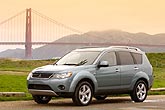
2nd Opinion – Sullivan
2nd Opinion – Sullivan Besides some hard plastic surfaces and the lightweight feel of some of the components, the 2007 Mitsubishi Outlander is a well rounded package worthy of consideration. What do you get when you combine the homely looking Subaru Outback with the ho-hum features of the Subaru Forester? A 2006 Mitsubishi Outlander. When you're playing second fiddle to Subaru styling, its time to rethink your design, and that is just what Mitsubishi did for the 2007 Outlander. The new design blends a stern looking front end with a lean profile bearing fender flares that resemble a Mercedes M-Class, and a sporty looking rear with privacy glass and Lexus-like LED tail lamps. Style carries over to the inside with black leather seats and a clean dashboard design. The interior is also functional with plenty of storage compartments, an emergency third-row seat, and a very cool tailgate which makes loading heavy items a breeze. On top of all this, driving the new Outlander is a pleasure. With this vehicle, Mitsubishi delivers a satisfying combination of paddle-shifting fun, V6 power, and all-wheel-drive handling. Overall, besides some hard plastic surfaces and the lightweight feel of some of the components, the Outlander is a well rounded package worthy of consideration.
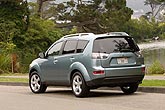
2nd Opinion – Wardlaw
2nd Opinion – Wardlaw The Mitsubishi Outlander is worth a test drive if you're shopping for a Honda CR-V or a Toyota RAV4. But with this appealing redesign, the company didn't quite cover all the bases. Fundamentally, this is a great little SUV. It's comfortable, it's roomy, it's fun to drive, and it gets decent gas mileage. Our XLS test model had a terrific-sounding Rockford Fosgate audio system, soft leather upholstery, a power sunroof, automatic climate control, navigation, and beautiful alloy wheels. Plus, the 2007 Outlander is a great looking vehicle, the likes of which have not graced a Mitsubishi showroom in many years. Cap this package off with one of the best powertrain warranties in the business and a fully-loaded price in line with what the average American pays for a new car today, and you might think the Outlander is a must-drive contender against the Honda CR-V and Toyota RAV4. You'd be right. Trouble is, after that test drive, you might wonder why the Outlander squats and lunges when you step on the gas, snapping the heads of your passengers, and why when you roll up to a red light that goes green, there's such a long delay before the engine and transmission figure out it's time to get going again. You might also wonder why Mitsubishi thought that glossy, hard plastic was appropriate for the upper door panels where you'll want to rest an elbow while driving, why the headliner and sun visors look and feel like they were ripped out of a 10-year-old Kia, why the stereo functions aren't controlled by knobs instead of rocker switches and the touch-screen navigation screen, why the steering wheel won't telescope for a better driving position, and why none of the storage areas save the one in the top of the dash is lined with felt or rubber to keep items from rattling and sliding. You might also wonder what the point of the third-row seat is, considering that in the Outlander it's little more than a lawn chair with seat belts and puts a bunch of gaps in the cargo floor. Finally, taller people need to watch their heads on the edge of the tailgate when it's open. On a more positive note, the Outlander offers terrific steering and braking response, coupled with some of the best road feel I've ever experienced in a SUV. The seats are comfortable, the climate controls are models of ergonomic perfection, there's a 110-volt outlet in the center console, the cargo cover is light and easy to remove, it's got dual gloveboxes, and the split tailgate design is exactly the kind of innovative, surprise-and-delight feature that can give Mitsubishi a leg up on the competition. I just wish I could say the Outlander has covered of the bases instead of of them.
Photos courtesy of Mitsubishi
